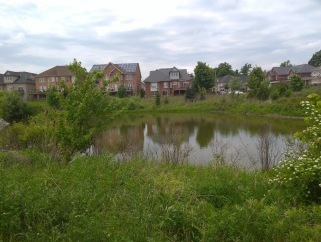Evaluation of a Geothermal System for Cooling Stormwater Pond Outflows – Brampton, Ontario
The replacement of natural cover with impervious surfaces during urban development results in significantly higher runoff volumes and rates, which can lead to flooding, stream erosion, aquatic habitat degradation and downstream infrastructure damage. Stormwater ponds are used to help mitigate these impacts by temporarily storing water during storm events, and releasing it slowly to streams at peak flow rates equal to or less than occurred prior to development. Unfortunately, the exposure of stored pond water to solar radiation causes significant warming. Higher outflow temperatures (often greater than 30°C) are detrimental to aquatic life because many species are sensitive to even small changes in temperature. Currently the Ministry of Natural Resources and Forestry suggests a maximum temperature of 24°C for the protection of endangered redside dace, but even cooler temperatures are preferred for brook trout and other headwater species.
To help provide cost effective solutions for addressing provincial thermal mitigation requirements, this project investigates the efficacy and feasibility of applying geothermal technology to cool stormwater discharged from a pond in the City of Brampton. Geothermal is often deployed in conjunction with a heat pump as an efficient means to heat and cool buildings. However, in this project, the system ‘load’ is warm stormwater runoff rather than the heating or cooling load of a building. The system consists of a deep geothermal borehole (approximately 180 m) connected in a closed loop with a pond heat exchanger. The pond heat exchanger is made from coils of polyethylene pipe and is installed inside a concrete vault downstream of the pond outlet. A heat transfer fluid flows through the closed loop and is able to transfer heat energy from the pond heat exchanger and reject it to the deep ground. When warm pond outflows move through the vault on their way to the stream, they pass over the coils of the pond heat exchanger, which extracts heat energy from the water, sending it to the closed loop and into the ground.
A small-scale pilot system was installed at a stormwater pond in Brampton in 2018. Thermal performance monitoring of the system was carried out during the summer of 2019 and continued in 2020. This evaluation will help determine the system’s cost effectiveness and capacity to cool stormwater. Results will be used to provide sizing and design recommendations for full-scale system implementation on other ponds. Long term operation and maintenance requirements will also be documented.

